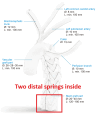Next-Generation Frozen Elephant Trunk Technique in the Era of Precision Medicine
- PMID: 39229636
- PMCID: PMC11392710
- DOI: 10.5090/jcs.24.089
Next-Generation Frozen Elephant Trunk Technique in the Era of Precision Medicine
Abstract
The frozen elephant trunk (FET) technique can be applied to extensive aortic pathology, including lesions in the aortic arch and proximal descending thoracic aorta. FET is useful for tear-oriented surgery in dissections, managing malperfusion syndrome, and promoting positive aortic remodeling. Despite these benefits, complications such as distal stent-induced new entry and spinal cord ischemia can pose serious problems with the FET technique. To prevent these complications, careful sizing and planning of the FET are crucial. Additionally, since the FET technique involves total arch replacement, meticulous surgical skills are essential, particularly for young surgeons. In this article, we propose several techniques to simplify surgical procedures, which may lead to better outcomes for patients with extensive aortic pathology. In the era of precision medicine, the next-generation FET device could facilitate the treatment of complex aortic diseases through a patient-tailored approach.
Keywords: Aortic diseases; Endoleak; Endovascular aneurysm repair; Spinal cord ischemia; Vascular grafting.
Conflict of interest statement
Suk-Won Song is an associate editor of the
Figures






References
-
- Carrel T, Sundt TM, 3rd, von Kodolitsch Y, Czerny M. Acute aortic dissection. Lancet. 2023;401:773–88. doi: 10.1016/S0140-6736(22)01970-5. https://doi.org/10.1016/S0140-6736(22)01970-5. - DOI - PubMed
-
- Vilacosta I, San Roman JA, di Bartolomeo R, et al. Acute aortic syndrome revisited: JACC state-of-the-art review. J Am Coll Cardiol. 2021;78:2106–25. doi: 10.1016/j.jacc.2021.09.022. https://doi.org/10.1016/j.jacc.2021.09.022. - DOI - PubMed
-
- Elefteriades JA, Farkas EA. Thoracic aortic aneurysm clinically pertinent controversies and uncertainties. J Am Coll Cardiol. 2010;55:841–57. doi: 10.1016/j.jacc.2009.08.084. https://doi.org/10.1016/j.jacc.2009.08.084. - DOI - PubMed
-
- Sakalihasan N, Limet R, Defawe OD. Abdominal aortic aneurysm. Lancet. 2005;365:1577–89. doi: 10.1016/S0140-6736(05)66459-8. https://doi.org/10.1016/S0140-6736(05)66459-8. - DOI - PubMed
-
- Chou E, Pirruccello JP, Ellinor PT, Lindsay ME. Genetics and mechanisms of thoracic aortic disease. Nat Rev Cardiol. 2023;20:168–80. doi: 10.1038/s41569-022-00763-0. https://doi.org/10.1038/s41569-022-00763-0. - DOI - PubMed
Publication types
LinkOut - more resources
Full Text Sources

